#arguably the whole party does things like this for each other
Explore tagged Tumblr posts
Text
Mike biking around to whatever friends house with treats and snacks and medicine whenever someone is feeling sick/down will forever be a hc I hold close to my heart
#he’s just ready with everyone’s everything at all times#max has a killer headache and isn’t able to pick up medication for it? Oop suddenly here’s Mike#Dustin’s been feeling bummed out?? Mikes suddenly there with piles and piles of newfound theory for them to deep dive into#Lucas twisted his ankle during a scrimmage and hasn’t been able to come out the house? oh woah crazy suddenly Mike is there to hang out#El’s having stomach problems? Mikes rushing in with medicine and easy to eat food#will has been having bad depression? here comes Mike ready to spend time and lend a hand#he’s just a helpful guy okay?#arguably the whole party does things like this for each other#I just think Mike would do it the most#byler#<<target audience#mike wheeler#stranger things#he’s the heart
15 notes
·
View notes
Text
Trying to parse my thoughts on Izzy's death and why I had a different reaction to it than I thought I would. To summarize: I thought I wouldn't like it, but also that they wouldn't do it; the opposite happened– they did it but I'm ok with it.
I'm also feeling like talking through some mourning for an amazing character, so follow along if that's you, too 😌
(I should probably clarify the following thoughts are coming from someone who deeply enjoyed this season.)
I first wondered what would be of Izzy around the end of season 1. I expected him to have a heel-face turn – which I object to calling a redemption arc and I'll get into why, because the distinction ties into his death imo. A lot of antagonistic characters' changes of heart end directly in death, but I thought they'd subvert that trope. And they... did, actually, despite Izzy dying. Not an option I had imagined.
What the show avoided is the logic, the set of tropes attached to the deaths of this kind of character. These deaths usually come as a consequence of the character's changed ethics or "redemption". My being against that scenario came from the diverging natures of traditional redemption arcs and OFMD's rhetoric.
A traditional redemption arc functions by a kind of catholic logic, if you will: the villain can become one of the good guys by balancing out his "sins"/bad deeds with enough good deeds to tip a moral scale. This often involves a purifying suffering, which acts as an agent to expiate one's faults. To the viewer, this suffering can serve to activate our empathy and make the character more sympathetic. It can also legitimize his quest: our trust in the character's good intentions comes from seeing that the character is ready to make sacrifices to become better and he isn't deterred by the hardships of doing the right thing.
The death occurring at the end of a traditional redemption arc acts as the ultimate sacrifice and/or purification. A number of ideas might be at play behind it, depending on each story: only in death can the soul become fully pure, or a final sacrifice is "needed" to demonstrate the change once and for all, or change was only possible up to a point after which there is no viable/acceptable future – the character deserves moral points for changing, but not so many that he also deserves a full life, or past crimes make him more expendable, etc.
But these are all ideas that aren't evoked in any of the crew's journey in OFMD. For starters, the show isn't interested in "catholic" redemption; its focus is on reintegration/rehabilitation into the community. Rather than appealing to the more traditional (in Western media) and more christian principle of "purification of the soul through mortification of the body", it plays with notions of restorative justice.
We see it especially this season with Ed and Izzy. Ed's arc is a whole little lab for it. We have the community being made to decide whether he can stay or should leave; catbell!Ed is made to apologize to the people affected – which he initially does abysmally, with what fandom has dubbed his "CEO's/YouTube apology". Later, he's given the opportunity to have a more honest and genuine conversation with Fang where he learns about how he hurt him. He's made to repair some of the material damage his behavior caused. Some members feel repaid by the idea that they did to him the same he did to them (Fang) while others don't (Lucius), and the show touches on what this means for each/legitimizes both feelings. Arguably, Ed using his treasure to throw Calypso's birthday party – a much needed refrain and moment of social (re-)connection within the community – is an additional form of reparation. While Stede's belief in Ed has a clear role in helping Ed change for the better, Izzy's s2 journey focuses even more intensely on the role of social support within an individual's constructive (re-)integration into their community. The show is condensed by choice of format, but the beats are all there.
With that kind of rhetoric set up, I'd never be able to accept Izzy dying in a way that feels like a punishment for his past crimes, nor in a way that should "confirm" his positive change/"purify" him for good. And he doesn't! By the time he dies, we know full well he's deeply changed, it's already established to completion. How it happens has nothing to do with proving himself – he's randomly shot in battle. It's never questioned that the time he got to live surrounded by affection mattered. The speech he gives Ed is only possible because he's changed, accessing a completely different perspective on piracy/life than before, like we see when he talks to Ricky earlier. The reason the whole crew is paying respect and crying is because he became "the new unicorn", a treasured member with a defined role. But his death itself is the show going back to the initial symbolism of Izzy as ultimate pirate. The narrative function of his death is underscoring that the age of piracy has come to an end. It's nothing to do with his change. It's posited as the "natural conclusion" (again, by symbolic function) of a character that represented piracy through-and-through, not the "natural conclusion" of a process of becoming better.
And for me, that difference changes everything. I can see and accept the logic behind it, even as I mourn Izzy as a character. It makes the grief feel like a catharsis I experience within the context of the story I'm watching, rather than a grief I feel from a show "betraying" me.
It's also a difference that completely changes how Izzy's death relates to his queerness. Izzy's change is intertwined with being able to express queer affection openly. Becoming "a unicorn" is this extremely queer imagery already – a magical rainbow creature. His role becomes akin to a mother to the crew (the mother hen!Izzy many headcanoned last season, tapping into his potential), a position that isn't extraneous to older queens, including our honored real-life mean-old-queer men. Last season he threatened another queer man for showing too much delicacy, effeminacy, vulnerability. Now, his change is a process that culminates in him singing a tender love song among the crew in drag. He's given the privilege of playing the soundtrack to our protagonists making love for the first time, which ties him symbolically to the event in a way it does no other crew member. Suffice it to say that insinuating his process of change should end in death would have been disastrous, as far as I'm concerned. Antithetical to the show's supporting ideology.
But that's not how it went. Grief occupies a big role in the queer community, but it's so rare that we get to experience it cathartically. In real life, we often have to contend with the ways queerphobia causes us trauma or even shortens our lives, or the lives of our friends. In fictional narratives, a lot of characters that get to express queerness unabashedly still die for the transgression. They're still usually the only queer character with relevant screen time or at all, at best one of two that formed a tragic couple.
We almost never have the opportunity to just mourn some motherfucker who died because they meant something else as well that was central to their character. To mourn and know we're mourning someone who wasn't ever punished for being queer-as-in-fuck-you and going all out. To mourn and not feel like it's another message of queer doom, because for once the character is surrounded by an entire crew of other queer characters that go on to live and be happy. To know the story is saying something about life, not about being queer. To know this kind of crafting was deliberate, too, because the creator has talked about working to avoid those tropes. I struggle to remember another time I had the opportunity to grieve for a queer character like they're a human being, without the implication that it's queerness itself that's a death sentence.
And honestly? It feels good. It feels like a form of catharsis I do not dislike. That I'm maybe kinda glad for. OFMD is and stays a magical world. Beyond that, in a show full of queers, one of them dies after getting some extraordinarily meaningful happiness, and it's peaceful, and I get to just be sad for the fucker without the gutting of being reminded that if you're gay, better not shoot too high. It feels like a completely different emotion that no other show, for now, would give me, but OFMD. To me, it's yet another thing it's pulled off.
As it's been known to do.
225 notes
·
View notes
Text
So my mum and I were revisiting one of our all-time favorite Christmas movies, The Muppet Christmas Carol, and I think maybe -- just maybe -- there's some really fun symbolism we've all been missing out on. And it all has to do with our main character Scrooge and the color red.

Okay, so at the beginning of the film, Scrooge is in all black, from head to toe. It makes him this wonderful dark shadow over the rest of the cast, and also makes him immediately stand out when he's in public, since everyone else is much more colorfully dressed.
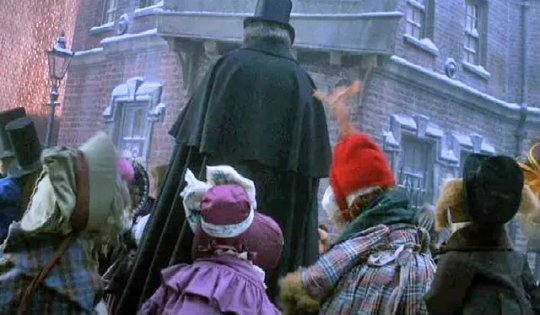
Contrast this especially to the people who are closest to him, Bob Crachit and his nephew Fred.
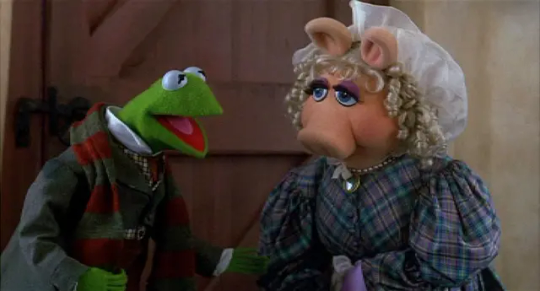
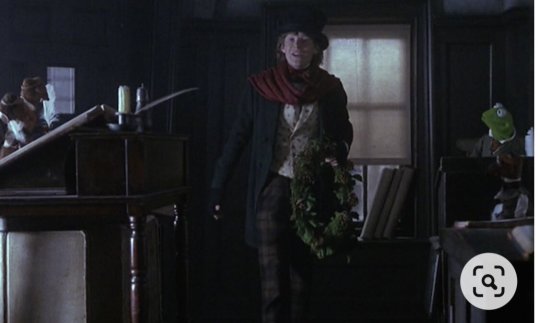
Well, well, isn't this interesting...both of them have red in their costumes. Even later on, at Fred's Christmas party, we see his wife also wearing red.
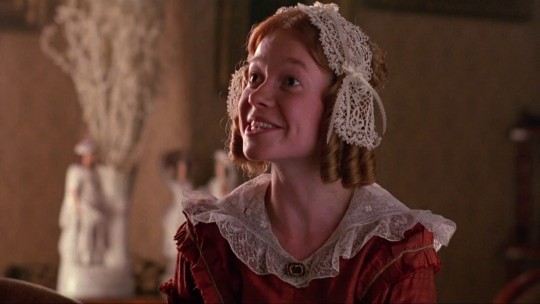
The Ghost of Christmas Present -- the ghost who in this film arguably influences Scrooge the most out of all of them -- has a bright red beard...
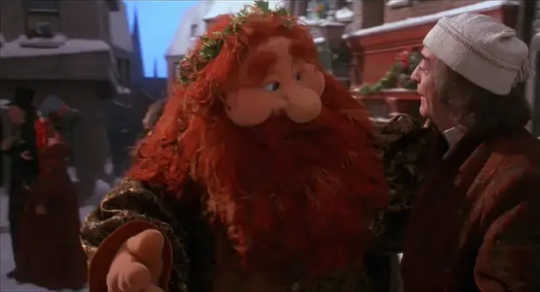
Oh yes, and we mustn't forget that our favorite narrator "Charles Dickens" is also wearing a bright red coat. (Even his friend Rizzo has some red in his scarf.)
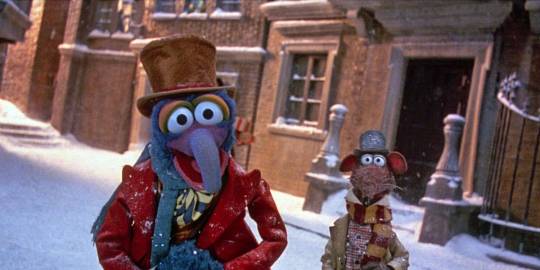
Red as a color can mean lots of different things symbolically -- violence, passion, anger, courage, danger...but I think the one most relevant to this reading is love and warmth. Why? Because even when we see Scrooge as a young man prior to the "all black" treatment, his definitive color is a dark blue.
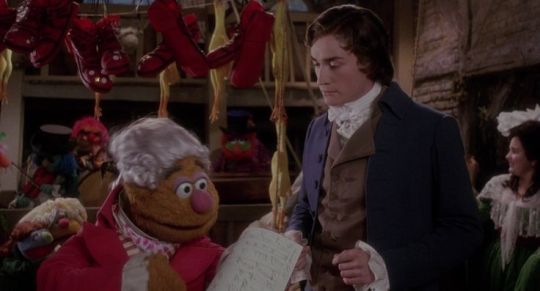
Notice how much cooler young Scrooge's overall color palette is compared to the much flashier, rosier Fozziwig. (And yes, I think that rosy palette is on purpose -- in the film, Scrooge even describes Fozziwig as being "as hard and as ruthless as a rose petal.") It also makes it so that when Scrooge meets Belle (at this point dressed in pale green with pink rose details), their palettes compliment each other a little bit more, even if Belle's look is still softer, lighter, and warmer in tone to Scrooge's cool, serious ensemble.
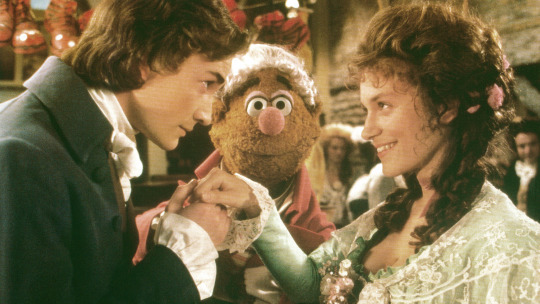
But when Belle and Scrooge part ways, we see them wearing colors that contrast much more. Scrooge is still in cool, detached blue, but Belle is in...

Red. Specifically, like Bob and Fred, she has red right around her neck, in the form of her bonnet's ribbon. And it's presumed that over time, after losing Belle and withdrawing more into himself and his own greedy self interest, that Scrooge lost the remaining color of his life and became the cold, black-hearted moneylender we see in the film.

Then of course Scrooge goes through this radical transformation thanks to the Ghosts of Christmas, as we all know...and the very first Christmas present he receives, as a thank you for his charity, is from one of the charity workers, played by Beaker. What is it?

A red scarf.
It's a gift given in the spur of the moment, and yet from Scrooge's reaction, we can tell it's something foreign to him. It's likely it's been ages since he's received such a modest, and yet heartfelt gift from anyone. Scrooge feels the warmth of the gesture, not just because a scarf keeps one's neck warm, but because it was given out of such sincere gratitude and kindness. And as startled as he is by it, he responds with such sincere joy, and wears it happily for the rest of the day. He wears that warmth as easily as Fred and Bob wore it earlier in the film -- as if it's become a part of him. And in a strange way, it has.
For the first time, arguably in his whole life, Scrooge has a true understanding of selfless, loving warmth. The warmth that he should and does feel for the people most central to his life and identity -- his nephew and niece-in-law, his loyal subordinate, his first employer, his first love...even the Spirits who taught him the true "meaning of the season." A kind, generous warmth that permeates the entire story of A Christmas Carol because it's what Charles Dickens loved so much about the holiday season and so wished to spark in his audience.

#the muppet christmas carol#analysis#opinion#the muppets#christmas#ebenezer scrooge#a christmas carol#disney
173 notes
·
View notes
Text
Happy 8 months of Challengers!!! Justin Kuritzkes interview with Al Horner
Shout out to Al, for asking great
questions!!! I thought this was a great interview.
Some of my favorite highlights from the interview:
AH: There’s a reading of this film and Tashi’s arc in particular that kind of like explores the idea, I suppose that like Tashi’s sense of injustice at what was taken from her as this tennis starlet who very much anticipated living one type of life is that like she has this kind of obsession with tennis and winning. She’s trying to vicariously live through Art, but it’s never going to fully satisfy her. And it leads to this, particular love triangle in which, well, the read online is “Patrick loves Art, Art loves Tashi, but Tashi is kind of incapable of loving either because she just loves winning so much, to the point it’s such a point of obsession.” I don’t know if I quite agree with it because like, I do think there’s genuine love for both parties there. But I’m curious what your take is or how you thought of the character as you approached her on the page.
JK: Yeah, I don’t think anybody is that simple, and I don’t think anybody ever wants one thing. I think it, it would be very tidy and very neat to say this one really wants -“He really wants her. She really wants him. All of that.” That I think is kind of like that’s just not as interesting to me as what I feel like is the truth about them, which is that they all want conflicting things. And you know, I think what’s frustrating for Tashi about these two guys is that in a way, I always thought of her as somebody who’s really hungry to be seen fully and to be understood fully and met as she is. Patrick and Art both see parts of her and are both in love with different parts of her. But neither one is in love with the whole thing. Neither one can accept the whole thing. And she is in love with parts of each of these guys, but can’t love the whole thing because they’re deficient in some way. And in a way that demand makes is her deficiency. You know, that sort of stubbornness is her deficiency, but also how could she demand less? She has too much respect for herself. So I think that then gets reflected in the way they all play tennis. Patrick plays in this very wild, naturally gifted, sort of explosive, athletic way. Art plays in this well mannered, studied by the book, disciplined way. But Tashi before her injury, had both. And that’s how you become a great tennis player. There’s a great essay by David Foster Wallace about Roger Federer. He talks about how there was a moment when tennis moved from being classical music to Metallica and that there was a sort of trend around the time that Federer became ascendant of power baseliners, like Nadal, for the most part, that his game is a lot of just power from the baseline. And of course, Nadal does a lot of other stuff very well, but that’s the predominant mode of his tennis, right? This overpowering of the opponent. It’s a very muscular sort of tennis. And what David Foster Wallace says about Federer is that he somehow managed to play classical music and Metallica at the same time. To watch that is liking meeting God. To watch that in person is like a religious experience. And so that was very much what I was thinking about when I was thinking about just how good Tashi is.
AH: There’s a crucial moment later on in the movie where Tashi secretly meets up with Patrick to ask him throw the upcoming match he has against Art and she’s doing this out of love for Art. She wants to boost his ego and arguably their marriage is on the line. It’s tied up in this game. She and Patrick have this explosive argument that leads to them having sex inside his car. And again, in terms of the ambiguity in this film, purposeful ambiguity, there is some debate as to how much of that was premeditated, how much of it was transactional almost, and I’m curious on how you approached all this on the page. Were you kind of aware or were you letting the characters dictate you on what they were doing or what was your read on the granular details of what everyone is doing in that scene?
JK: Well, I think, again, sometimes people are doing things for more reasons than they know, and sometimes people are not on top of their own motivations. And that’s a very exciting place for a character to be because there’s a tension between what a character is saying and what their body is doing. A character is revealing themselves in ways they’re not intending. And I was just as surprised by all of that as I was writing it, as I think people watching it probably are. That was really at that point in the movie, I was trusting the characters to go where they wanted to go. So, yeah, I think I like that you said that she is doing it some respect out of love for Art. Because I do think there is a real part of Tashi that is genuinely trying to make this marriage work for her. And she knows herself well enough to know that if he gives up right now, if she has to watch him completely give up on his career and on his potential and resign himself to being done before he’s forced to by time for instance, that she will not be able to love him. She won’t be able to be there for that. So there’s that. There’s also the fact that Art is the person through whom Tashi has been playing tennis for 10 years or however long it’s been. And so she knows that the moment that Art’s tennis career is over, that’s the end of her tennis career, and she’s not ready to give that up. So she needs that. And at the same time, she probably really, there’s a part of her that really wants to see Patrick and really wants to get into that car, and she wants to jolt Patrick out of his slump and out of his self pity and out of his bullshit. So I’m not sure she knows at the moment that what she’s really after is what ends up happening at the end of the movie, where everybody’s cards are out on the table and they’re all pushing each other to in some ways be the best selves and in some ways be their most naked selves. I don’t know if she’s got enough of a handle on the situation to have a fully planned to that’s where she’s trying to lead everything. But I think she’s got a lot of different competing stories that she’s telling herself about why she’s in the car.
And Patrick is the kind of guy that goes, you do want to fuck me, you’re here because you want to fuck me and you’re so full of shit, you won’t admit it to yourself. And that says everything about why she feels the way she does about Patrick, both good and bad.
Tashi has easily become one of my favorite characters and it’s nice to hear when your interpretations are similar to the writer and actress’s interpretations. It feels like I’m not just spitballing lol.
Justin also talked about how the signal was something that was always there and he was writing towards it. Also shoutout to pega on Ao3, Justin said if Art wasn’t playing tennis, he’d be in medical school. You cooked on that one. He also talked Luca mentioning the corners of the love triangle literally touching and how important it was to include a scene where all 3 of them have a moment of togetherness and it being a major thing that the 3 of them are trying to get that feeling back again.
#tashi duncan#tashi donaldson#Patashi#artashi#challengers#challengers movie#challengers 2024#zendaya#justin kuritzkes#Spotify
26 notes
·
View notes
Text
Ok so we all know how amazing Baldur's Gate 3 is. I could talk for hours about everything it did perfectly.
But rn, I want to talk about what I think Dragon Age Inquisition did better. And this is not to judge which game is better overall, but what still makes DAI so special to me despite its flaws.
1. Voiced protagonist
Yeah, starting off controversial. I know some people prefer silent protagonists, but I just find myself wishing we could have a fully voiced Tav, even at the cost of fewer dialogue options. I'm sorry, but Tav's silent indifferent face just always breaks the immersion for me, especially when contrasted with the award-worthy acting and animation of the characters they're speaking with. In DAI (and DA2, although to a lesser degree) your character could be heavily customized, but they were always an actual person who fit in with the rest of the universe and flowed seamlessly with the story.
2. Mystery and dread.
BG3 is full of heavy, scary, traumatizing stuff hidden all over the place (or in plain sight). But it can always be explained in some way. There are dreadful things in Faerûn, but we always know what they are (mostly due to most of them having to have precisely given stats as the result of being based on DnD). We know what happens after death and what we can do to bring people back from it. The closest you get to truly dread-inducing mystery in BG3 is "Do Illithids have souls" and "where do illithids come from" and (at least in Act 1) "who is the Absolute".
In Dragon Age, the whole world is made of existential dread. What happens when you die? Dunno. Is God real? No idea and if He does, He hates you. What is the Blight? Are all darkspawn capable of independent thought? What is lyrium singing about? What happened to the titans? What happens when all of the Old Gods die? And this is just the Big Questions. There's a myriad of small things, small mysteries you encounter that just have no answers. Stuff that reminds me of those creepy Goldshire children forming a pentagram in World of Warcraft. While having an explanation for everything makes for deeper worldbuilding, a world full of mysteries without answers makes for a much scarier and, in some ways, exciting experience.
3. Group dynamic and party banter
I enjoyed the party banter in BG3. Hell, it had some of the funniest lines in game. But it didn't do enough to make the group dynamic feel any less Tav/Durge-centric. You hear the companions exchange banter, but you never get beyond stuff like "Karlach and Shadowheart both enjoy wine" and "Gale enjoys Lae'zel telling him about the Astral plane". The protagonist forms amazingly written relationships with each of the companions, but they never seem to have such a bond with one another. The closest we come to what I'd like to see is Karlach and Wyll's friendship, but even that's kind of shallow, I feel. The companions do comment on the others' personal quest, but it's always one sentence reaction, before going right back to being mostly indifferent. DA2 had the same issue, if to a greater extent (srsly, the companions had the same attitude about one another over the span of 10 years)
The banter in DAI was superb. It told a story. It had arcs. You could watch in real time as Solas and Dorian became friends over their shared magical nerd-dom. You could even take part in it, such as when telling Blackwall to stfu about jousting for a moment, or telling Sera that what you and Solas do in private is none of her business. You could see Dorian and Bull fall in love. You could watch Varric slowly chip away at Solas' worldview until he arguably came closer to changing his plans than Lavellan ever did. The relationships grow over the course of the story and by the time of Solas' betrayal, you're not just sad because he betrayed you, you're sad because he betrayed Varric, Dorian, Bull, Cassandra and everyone else. Because you saw how they cared about him, each in their own way.
There is nothing more heartbreaking than Varric's "Chuckles, what have you done?"
In BG3, the relationships are mostly left to your imagination, which has its perks, but still, the group dynamic feels more like a wheel with Tav at the centre rather than a web.
4. Having limits on the romance options
Let me start by stating what I am not saying: I am not saying that bi and pan people shouldn't be represented. Far from it. But I don't think making the whole group pan is the way to go about it. I can't help but feeling it is, in a way, pandering to players, making every single companion interested in them as long as they have a sufficiently high approval.
Making some companions explicitly bi, pan, gay or straight made for a more real experience. Getting rejected by Sera on the grounds of "We have a lot in common - we both like women" felt disappointing, yes, but also real. This also allowed the writers to make the characters' sexual/romantic preferences a part of their, well, character. We got Dorian's personal quest, which I think is great. Limiting Solas' options to just Lavellan allowed the writers to make it about him realizing that his people are not mere shadows. It allowed them to write the Vallaslin scene. None of this could have been done if he were romanceable to all races.
When you have diversity in romantic attraction among the companions, suddenly the pan and bi characters (in Bull and Josie respectively) feel like their orientation is part of who they are, rather than a game mechanic to prevent players from missing out on content.
#baldur's gate 3#dragon age inquisition#this is all just my opinion#i am still salty that the devs didn't get more time to do DAI properly#imagine DAI made with the love care and time that BG3 had#we could have had another masterpiece
112 notes
·
View notes
Text
Camilo Analysis
Bruh, who even is Camilo? He is arguably the Madrigal we get the least real characterization for, other than Teenage Boy, which is a very broad category of person. So as per usual, it helps me to get my thoughts in order if I write this stuff down.
First, Mirabel introduces Camilo through song and we right of way see him shapeshift into a young mother so he can sooth her baby while she takes a nap. That's actually a really great way to imply several things about his character (oh my god guys, this movie is so well written).
Thoughtful enough to offer a new mom a chance to rest
Comfortable caring for infants (probs helped care for Antonio?)
More patient than I would have thought, because taking care of a baby while the mother rests is not a quick and easy favor
Sort of implies that he likes kids
Then Mirabel sings he "won't stop until he makes you smile today" while he turns into multiple people and doing goofy stuff. Everybody already knows he's an entertainer at heart but I gotta add it to the list anyways.
5. Likes making people laugh
6. Plays around with his gift a lot
Moving on to Antonio's party, he's the guy greeting all the villagers by name, and he changes his energy to match each person.
7. Knows a lot of the villagers
8. Charming and personable
9. Respects his elders (kisses the old woman on the cheek)
He jokes around with Antonio, probably in an attempt to soothe his nerves, and teases his Pa. This reinforces points one, four, five and six. If this was a different list, I would talk about what it means that Camilo is clearly comfortable teasing his father, despite the seemingly stern reaction Félix has, but I digress.
He stands with Julieta while Antonio and Mirabel walk to the door, giving birth to a lot headcanons about them being especially close, and I'm going to roll with it.
10. Of his siblings, he's closest to Julieta.
Then he's very excited for Antonio as he discovers his room, it's actually the happiest we see him in the movie (other than perhaps when he's dancing in We Don't Talk About Bruno). So:
11. Supportive? Or maybe just enjoys seeing other people happy?
Plot happens, fast forward to breakfast when he pretends to be Dolores so he can get double the food. Then teases Isabela about Mariano, something he does a lot in the movie.
12. Likes food.
13. In his Little Shit era
Fast forward some more, all the way to We Don't Talk About Bruno. He absolutely kills it, and clearly enjoys the whole production. If you're like me and you headcanon that the musical numbers happen in universe then we can conclude:
13.5. Fucking loves living in a musical
And if you headcanon they don't:
14. Enjoys telling stories.
15. Probably hasn't thought through the consequences of telling everybody his Tío is a seven foot tall boogy man that feasts on screams. Which is very normal for a fifteen year old boy.
Teases Isabela about Mariano again. More plot happens. Time For Dinner. Dolores gossips to him as soon as she can, then he immediately gossips to his Pá. When Félix accidentally spits his drink onto Mariano, Camilo has to hold in a laugh. It's possible he doesn't really like Mariano, he keeps making jokes about the guy, at the very least he doesn't take him seriously. I wonder if he's the sort of guy that prefers to hang out with women?
16. Close to his sister.
17. Close to his father.
18. Shapeshifts reflexively/accidentally.
More plot. We see him try to soothe his mother.
19. Takes care of his Má. Pepa is literally unable to hide her emotions, so it would make sense that, through no real fault of her own, the kids slowly learn to take care of her as they grow up. The squeaky wheel gets the grease and all. On the flip side, the fact that sun beams come out whenever they get home from school or learn a new skill probs means the kids can never doubt that Pepa loves them. Plus, she likely has the easiest time transitioning from a parent-child relationship to a parent-adult offspring relationship of all the adults. So Camilo might be growing closer to his Má as he gets closer to adulthood.
The longer the plot goes on the less we see him. He's clearly frustrated with his gift glitching on him, but that doesn't really tell me much. It's a situation that would frustrate anyone and they don't show us how he handles those negative emotions. They also don't show us how he handles hearing the end of Mirabel's and Abuela's argument. Rude. They do show us him leaping to the candle's aid while the house crashes down around him so clearly:
20. Sees the Miracle as more important than his own safety.
The house falls, the candle goes out, in the background we hear him first remark on his gift being gone, then wonder how this will effect his little brother. We already know he enjoys using his gift, I can theorize he's made Being a Shapeshifter an important part of his identity, but all we have that's concrete is:
21: He doesn't just enjoy his gift, it is important to him.
22. Empathetic.
Mirabel runs off, resolution happens, Mirabel comes back. He is the one who cuts through the reunion to point out their house is gone, and even gets a little exasperated when he catches a bit of flack from Félix.
23. Not an optimist. Might be a pessimist, but most likely just not particularly sentimental.
For the rest of the scene he exists in a state of confusion. The hits start coming and they don't stop coming. Apparently Tío Bruno is just suddenly back now? And it kind of seems like half the family isn't surprised or asking any questions?! There's not a lot of conclusions I can draw from him being shocked and confused that Bruno just sort of appeared out of nowhere, I think most people would be. And unlike the parents or the older cousins, he doesn't have enough memories from when Bruno was around to be swept up in the joy of seeing him again. His reaction is relatable and endearing, but not very revealing.
The last character moment we get is when he tries to twirl the shovel around all fancy, almost drops it, then checks to make sure Mirabel wasn't watching. It reinforces things already mentioned, like him being showy, and wanting to entertain those around him, but also:
24. Wants to be seen as cool. Another very normal trait for a teenage boy.
It is interesting that the first person he looks at is Mirabel, I can't help but wonder if that would have been the case at the beginning of the movie. There's room for interpretation there, but regardless, by the end of the movie:
25. Respects Mirabel's opinion.
66 notes
·
View notes
Note
What attracts you to Imotohan? Idk if I get it yet….
One day I should make, like, a ship manifesto...
Today is not that day; instead, you get a collection of references to other posts that I found when I couldn't sleep last night.
Reason Number 1: I really like enemies to lovers as a trope.
I always have, ever since I started reading fanfic way back in the day with Kim/Shego lol. But I especially love when two characters allow me to totally buck the more traditional power dynamics of one party having all the power while the other has none, which I find boring and not at all fun to explore.
At first glance, Otohan does have the upper hand a lot of the time in their dynamic (I mean, hell, they start out by slaughtering half of Imogen's friends and the love of her life). But it’s pretty easy (and very fun) to give Imogen opportunities to be on equal footing with Otohan or even surpass them entirely. And the Tension that comes with exploring two characters who hate each other but can’t help but be attracted to each other is just what I find the most interesting and fun to explore in my own writing in particular.
Sources (lol):
Cool Art that really HITS with the Enemies aspect.
Would also be remiss if I didn't plug Shamie’s art, who has created So Much art because I throw money at her every chance I get. Just scroll her whole otohan thull tag, you won't regret it.
Good Thoughts with my own tiny addition about shipping culture in general.
A nice little ask about characterization and violence.
Reason Number 2: They’re obsessed with each other.
To the point that the cast themself see it and take advantage of it in-game (see here, when Sam pulled 'the one you're so keen to meet with' out of his ass, assumedly failed a deception check, and yet Otohan still either humored them or just zeroed in on 'Imogen? Where's Imogen? Tell me where Imogen is' anyway like a fucking simp.)
Otohan in particular also displays a frankly terrifying amount of ��care’ and effort in getting Imogen to exalt in the battle at Bassuras, which I talk more about here. It’s what kicked off my intrigue with this ship and got me to try my hand and writing them (and then never stopped, as you can see).
Imogen, for her part, is just understandably terrified of but also constantly infuriated with Otohan (shitpost that shows that well). She says Otohan’s name with such vitriol and I adore her for it. Very ‘I’m gonna punch you in the mouth with my own mouth’ energy.
Here’s some video clips that show off their actual in-game dynamic really well, this one brilliantly set to My Kink is Karma (thank you @corkulous) and another to Death of Me (a million thanks to @lavendertheys).
Reason Number 3: They push each other’s buttons really damn well.
Arguably the most important thing in a ship for me after Tension.
We saw Otohan lose their patience exactly once, in my opinion, during the final battle when they called Imogen a ‘bitch,’ and as I said in this post, I think Imogen deserved so many more opportunities to rile Otohan up like that, especially in actual conversation as opposed to combat. She’s just so good at it, by golly, and if I can't see it in canon I can at least write about it.
And I mean, Otohan got Imogen to exalt (the only time she has done so, to my knowledge) and blow up a whole city block; I think it's safe to say they can get under her skin if they work at it, and I wish they had even more horrible opportunities to do so in canon before they kicked the bucket.
Anyways, that's the gist of what attracts me to Imotohan. If you don't get it, then the ship might just not be for you, which is totally fine—to each their own! Thanks for giving me an excuse to yap about themb~
#malloy sometimes speaks#asks#will i ever use a consistent ask tag? unlikely#imogen temult#otohan thull#imogen x otohan#imogen temult x otohan thull#imotohan#critical role#cr3#being a menace to the fandom and character tags in order to spread my ship agenda
25 notes
·
View notes
Text
Top 10 Maleficent Appearances
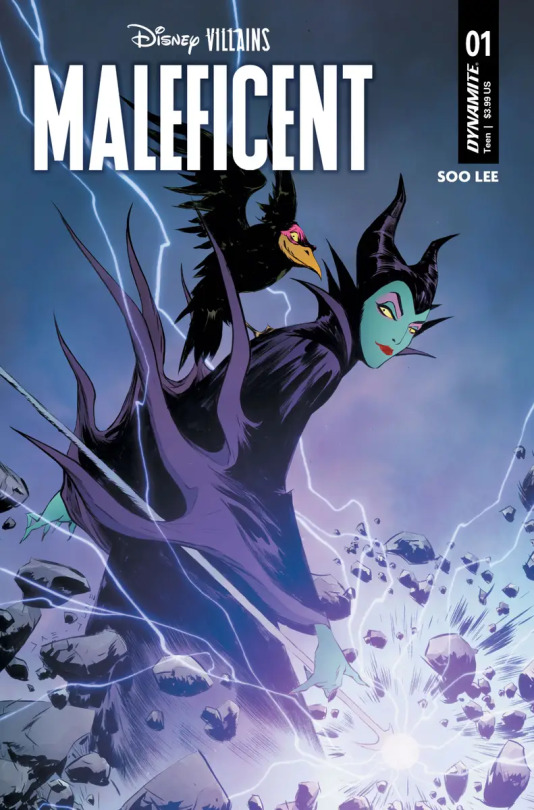
Earlier this week, I decided to celebrate Founding Day for Disney by discussing my favorite appearances of their flagship character, Mickey Mouse. However, as anybody who knows me well will likely be aware, Mickey isn’t my primary draw for Disney. None of the Disney heroes are, really. For me, the biggest group of characters that fascinate me most with Disney are its Villains. And while there are many great Disney Villains that I love - Scar, the Evil Queen, Jafar, Cruella De Vil, and more - my favorite has always been, and likely always will be, the Mistress of All Evil herself: Maleficent. Originally debuting in 1959’s “Sleeping Beauty,” this dark fairy is arguably for the Disney Villains lineup what Mickey is to Disney as a whole. While not unanimously EVERYONE’S favorite Disney Villain, she is in the top ten for many, many people. More importantly, she is arguably the single villainess with the most clout Disney has created: in virtually anything that promotes the lineup, Maleficent is used, and usually has some sort of starring or majorly featured role. She’s often depicted as the leader of the villains, and it’s no surprise why: with her stone-cold demeanor, grandiose style, and absolutely REMARKABLE feats of power and menace, she is easily one of the most dangerous and despicable villains the company has forked out through their animated productions. Maleficent is not only my favorite Disney Villain, but quite possibly one of my top three favorite villains of all time, alongside Count Dracula and Batman’s Joker. And, seeing as Halloweentime is usually Disney’s “Season of the Villain,” and this IS still the 100th Anniversary of Disney itself…yeah. Now seems a perfect time to cover my favorite appearances this Dark Queen has had since her debut. On that note, no, the original Sleeping Beauty will NOT be counted here, simply because I think that’s cheating. This will be for all of Maleficent’s greatest roles since her cinematic premiere. With that said…here are My Top 10 Maleficent Appearances (besides Sleeping Beauty)!
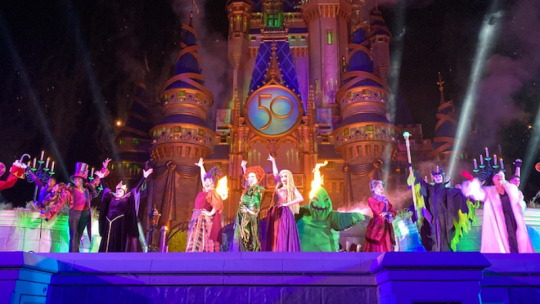
10. Villains Mix & Mingle/Hocus Pocus Villain Spelltacular.
Our first entry on the countdown is a Halloweentime special stage show at Walt Disney World’s Magic Kingdom. This show has changed several times over the years, and with each revolution, Maleficent has been present in some form or another. The original version of the show, called “Villains Mix & Mingle,” featured Maleficent and Captain Hook as the hosts of the Event; it was basically a story-less mini-revue, dedicated to Disney Villains. The “plot” had Maleficent throwing a Halloween Party (I guess she was tired of not being invited to any herself), and summoning various Disney Villains to dance the night away. In the late 2000s, the show changed to have Dr. Facilier as the sole host of the event. Maleficent still appeared, but was now simply one of the basically mute villains attending the festivities. More recently, the show has not exactly vanished so much as evolved into a whole new production, known as “Hocus Pocus Villain Spelltacular.” This much longer, slightly more story-based version has the Sanderson Sisters throwing the ball. Facilier, Maleficent, and Oogie Boogie are all featured in major supporting roles, while other villains once again show up as mute guests to the party. Halloween is the “Season of the Villain” at the Disney Parks, as I said before, and few villains match the spirit of the season as much as Maleficent does; if this stage show and its many iterations proves one thing, it’s that the Mistress of All Evil is as synonymous with Halloween for Disney as ghosts and goblins are. You simply can’t have a gathering of baddies in the autumn and not feature her at all.

9. Once Upon a Time.
I’ve always had sort of mixed feelings about the version of Maleficent from the TV series “Once Upon a Time.” This interpretation tried to make the character a much more sympathetic antagonist than arguably ever before. Her origins are shrouded in tragedy, and a major part of her motivations in the show comes from her seeking her long-lost daughter. (It seems to be a recurring thing to make Maleficent a mother or mother-like figure…I’m not entirely sure why.) Actress Kristin Bauer von Stratten brought her all to the role, and while I never liked her first costume design, the one that appeared in the “Queens of Darkness” story arc (pictured here) was a VAST improvement. My problem with this Maleficent is that they couldn’t seem to decide what kind of character she should be; I had no issue with the more sympathetic portrayal, on the whole, but it bugged me how they were always building her up as this figure of ultimate evil in many bits of dialogue, only to then whip around and show her as more tragic or more reasonable than other, very obviously worse villains. If you want to make her the Mistress of All Evil, go with that; if you want to make her a sympathetic villainess, that’s fine, too. But trying to do both at the same time? That’s a hard job to try and pull off, to say the least. I did come to like her more and more as the show went on, but I still don’t feel justified putting her up in the higher spots of this list.
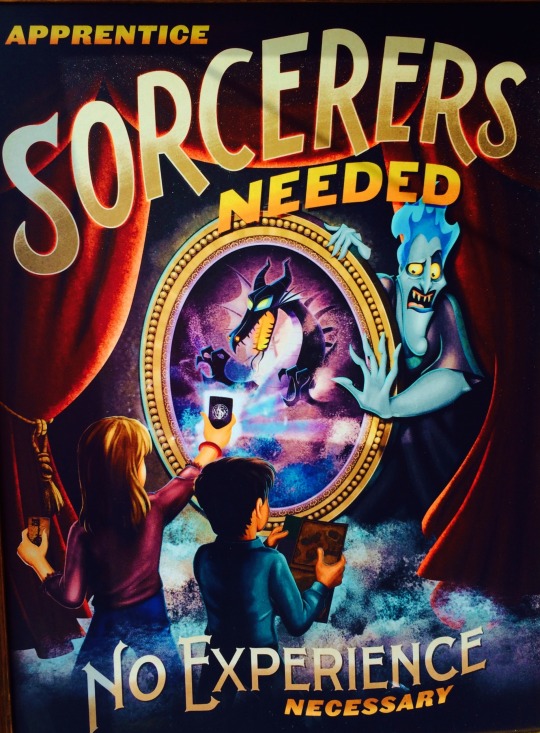
8. Sorcerers of the Magic Kingdom.
This is an interactive attraction at Walt Disney World’s Magic Kingdom, and perhaps the element most admirable about it is that it has...a plot. A real, true, honest-to-goodness plot! That’s something other entries on this list related to the parks tend to lack. The game has guests/players traveling throughout the park to find a variety of magic portals, through which they can interact. The story has the player(s) as apprentices of Merlin, trying to stop Hades from taking over the Magic Kingdom. The God of the Dead goes about finding various villains who, having been defeated and presumably killed in life, now take residence in the Underworld. He offers each one a chance to take back power, if they will help him in finding a bunch of special crystals needed for his plan. Maleficent is one of the villains Hades summons, but if you think the Mistress of All Evil has any intention of playing second fiddle to the Lord of the Underworld, think again. During Maleficent’s section of the story, she accepts Hades’ offer, but secretly plans to use the crystals for herself to take over the entire world, and then put Hades out of business, allowing her to become the most powerful villain in the universe. (Gotta give her credit for ambition.) It’s up to the guests to get past Maleficent’s many traps and minions in order to stop her, before either she or Hades can put their fiendish schemes into motion.
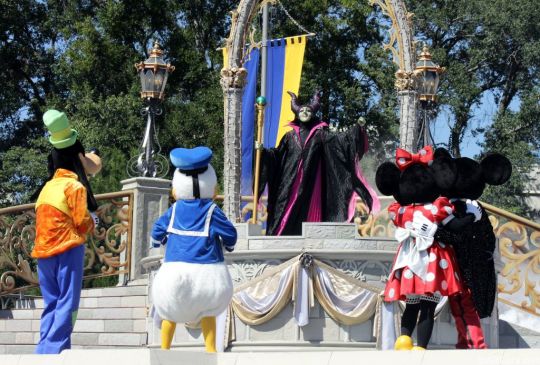
7. Dream Along With Mickey.
Yet another stage show from the Magic Kingdom! This production ran for ten years, between 2006 and 2016, before being eventually replaced by “Mickey’s Royal Friendship Faire.” The plot revolves around Mickey Mouse, Minnie, and Goofy trying to teach Donald Duck the importance of dreams and belief. About halfway through the show, the gang playfully pretend to be pirates…which results in the sudden appearance of Captain Hook and Mr. Smee. The two are naturally beaten by the intervention of Peter Pan…but just as it seems victory has been achieved and all is well, it’s revealed that the pirates are actually working for - you guessed it - Maleficent. The evil fairy arrives to terrorize the party, declaring her intentions to change the Magic Kingdom “into a Place Where NIGHTMARES Come True!” (I should probably mention that Maleficent’s appearance is highlighted by an instrumental version of “Hellfire.” EPICNESS.) Though ultimately defeated - because villains never prosper - Maleficent vows to return, warning the mouse, duck, and all “One day the Kingdom will stop believing, and all will be lost!” This is one of Maleficent’s biggest appearances at the Parks, in SEVERAL ways, and it’s a pity the show no longer runs at Cinderella’s Castle. Que sera sera.
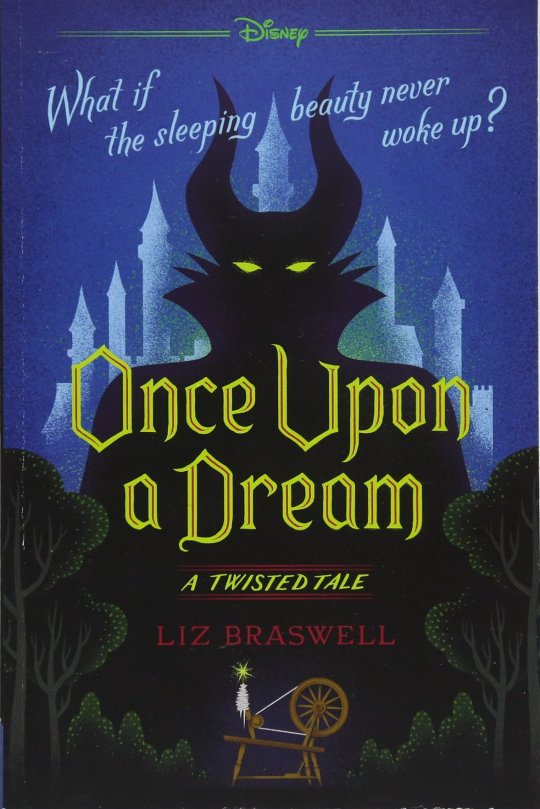
6. Once Upon a Dream.
This book is part of a series called "Twisted Tales," published by Hyperion and written by Liz Braswell. Each one of these books starts off with some sort of eye-catching question and premise related to a famous Disney feature. In this case, "What if Sleeping Beauty never woke up?" The plot has it set that, after slaying Maleficent as the Dragon, Prince Philip goes to awaken Aurora, just like in the film...but then something goes horribly wrong. For some reason, instead of waking the princess with true love's kiss, the prince falls asleep, too! The plot then shifts, as we find ourselves in what seems to be a parallel universe, where Aurora is Maleficent's daughter, and the Mistress of All Evil is controlling the entire kingdom. It's quickly made clear that - as you may or may not have guessed - this is a dreamworld going on inside of the head of Aurora and all the other denizens of the kingdom. The Princess has to figure out a way to beat Maleficent - with Philip's help - and wake up from the nightmare. What's great about this story is that Maleficent is kept in-character. She remains cold, crafty, and above all, VILLAINOUS: she's still the bad guy in this story, and she feels, generally speaking, like the character we all know and love to hate. My only problem with this story is that it feels like it borrows a lot from another Disney movie, "Tangled," with Maleficent essentially in the Mother Gothel role, Aurora as Rapunzel, and Philip as Flynn Rider. (All of their names even sound vaguely similar, now that I think about it.) But there's enough different about it to make it interesting, and I appreciate the novel using the “Maleficent as a Mother” trope (which has, again, become unusually popular) while still deciding to make Maleficent the dastardly adversary we all worship and abhor by the end of the tale.
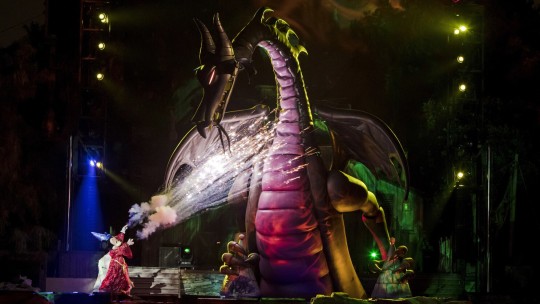
5. Fantasmic!
This is one of the most lauded, spectacular, and looked-forward-to shows at the Disney Parks. It’s currently still put on at Disneyland and Walt Disney World, and there used to be versions done for Tokyo Disneyland. Maleficent’s role in the proceedings is nominally very small, but the impact her appearance makes cannot be understated. While every production over the years has made some changes, the premise of the show remains the same: Mickey Mouse guides us on a trip through his own little dreamworld, where his imagination reigns supreme, and every story ends happily ever after. Everything is fun and fancy free (ha ha), until the Evil Queen gets wind of what’s going on. Incensed, she summons various Disney Villains to help her “turn that little mouse’s dream into a Nightmare Fantasmic!” This culminates in the arrival of Maleficent: “Now you will deal with me, and all the Powers of MY IMAGINATION!” In every version, the grand climax of the show has Maleficent transforming into her dragon form, and SETTING THE ENTIRE DREAM WORLD ON FIRE. (Yikes!) In the midst of this fiery chaos, Mickey must step forward and remind the villains just whose dream this is, defeating the mighty dragon in the process. It’s by fair one of the “biggest” shows in Disney history, and certainly one of Maleficent’s “biggest” appearances (in more ways than one). I was very sad and distressed when I heard that, recently, the Disneyland version of the dragon experienced some...technical difficulties, so to speak. You can look up what I mean, if you don't know already. What this means for Maleficent's future in the production is presently hard to say for sure, but I think it's unlikely she'll be leaving Mickey alone for good anytime soon.
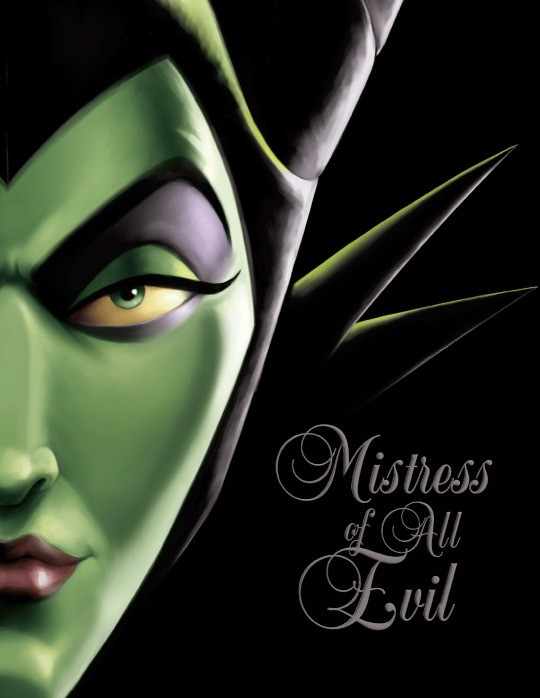
4. Mistress of All Evil: A Tale of the Dark Fairy.
Take notes, “Maleficent” movies and “Once Upon a Time.” If you want to try and provide a backstory to Maleficent, and make her more sympathetic, THIS is how you do it. While this book - part of a series by Serena Valentino, showing the backstories of various Disney antagonists (and the Beast...for some reason) - is not exactly perfect, it certainly achieves that aforementioned goal MUCH more successfully. In this book, Maleficent is still the elegant, dangerous, graceful enchantress we all remember, but we learn the reason why she’s so very wicked, and we also learn that her reasons for what she did in the film were much deeper than one might have expected. It also makes us see that the heroes of the story were not always so squeaky clean, and while it doesn’t totally vilify them - Maleficent is still decidedly evil in her actions, and they are decidedly good - it makes it clear that the line between the two extremes isn’t always as clean cut as we would expect. In short, this book is what I think those other versions, especially the Jolie-starring movies, tried to be: essentially Disney’s version of “Wicked,” taking a lot of the same themes and even some slightly similar story elements from those earlier films, but using them in a much better way than before. Again, it’s by no means perfect, as a book OR as a backstory, but it ultimately does much more and manages to work much better than other similar attempts. And since Maleficent is the focus, it once again stands as something quite unique in her catalogue of appearances.
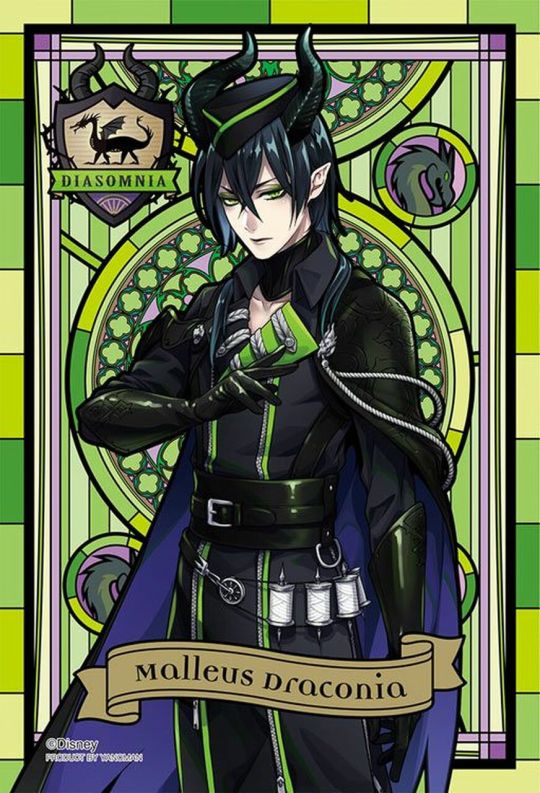
3. Twisted Wonderland.
Okay, so, this is KIND OF cheating, but I'm sorry, I HAVE to talk about this game. "Twisted Wonderland" is a mobile video game, in which your character gets "zapped" into an alternate universe. In this universe, they find themselves at a School of Black Magic which was inspired by seven of the great Disney Villains. (I have no idea how THAT happened, but whatever.) Among them is Maleficent, but although she is referenced several times, the Dark Queen HERSELF is relatively peripheral: she's long dead by the time the story begins. No, the focus of the game is on the students and staff of the school - Night Raven College - who are all based on (and sometimes descended from) the classic villains in question. One of the most prominent characters in the game is a descendant of Maleficent: the half-dragon Prince of the Dark Fae, Malleus Draconia. What's great about Malleus is what's great about all the characters in the game, really: unlike the "Descendants" franchise, which has a slightly similar premise, these characters are not merely stock figures who ride the coattails of the classic baddies of yore. Instead, they keep elements of the original villains close, but enough is changed about them to make them unique and interesting figures in their own right. Malleus has Maleficent's sense of style and aesthetics, and like her, his fury is a dangerous thing to provoke. He’s one of the most powerful beings in the entire WORLD, in the universe of the game, able to control the elements through his sheer will…yet despite all that power, and his dark aura, he’s got a lot of soft spots and some noted vulnerabilities. He CAN be dangerous and intimidating, make no mistake: he's more than aware of his power and who and what he is. Underneath it all, however, he’s a very lonely soul who longs for a sense of real companionship and belonging. I really can't do this guy justice with just a short written description; you really need to look into this title and this character for yourself. Ever since I met him, he was a shoe-in for my Top Three.

2. Kingdom Keepers.
This novel series by Ridley Pearson is essentially a darker, Disney-fied version of “Night at the Museum.” In the books, it’s revealed that, late at night, when everything closes down, all the attractions and rides and so forth at Disney Parks come to life, and many of Disney’s characters come to life, too...both good and evil. Enter The Overtakers - a band of nasties (most of them Disney Villains) who want to, as their group title suggests, take over the world. (OF COURSE!) Maleficent is one of the key antagonists of the series: she is the second-in-command of the Overtakers, the only character outshining her being the devilish Chernabog. You could almost say she is the Darth Vader of the franchise, in comparison to Chernabog’s Palpatine. This version of Maleficent has one interesting differentiation from her original film counterpart: while the original Maleficent was a being of fire - able to transform into a dragon, vanishing in flashes of flame, etc. - this Maleficent is as frosty as her heart. Everywhere she treads, she emanates an aura of coldness; where she steps, ice forms, and she prefers to hide out in chilly places. She still has power over flame, of course, among all sorts of other magic, but it’s this constant, frigid aura that makes her stand out. Anytime our heroes - a group of teens tasked with stopping the Overtakers - venture someplace with even the faintest chill, they get worried, and anytime things get dark and cold in the atmosphere, the reader immediately gets nervous or excited, wondering when the Mistress of Evil is going to make her grand entrance. I really love these books, and I’d love to see Disney do some sort of movie or TV series based on them sometime. Personally, I’d pick Cate Blanchett or Eva Green for Maleficent, if they ever do…but I digress.

1. Kingdom Hearts.
As the secondary antagonist of this highly popular video game series, “Kingdom Hearts” has probably done more for Maleficent’s popularity than anything else she’s been in. Almost anytime I bring up this Evil Fairy, her role in Kingdom Hearts is not far behind. In the first game, Maleficent was really the main antagonist, until Xehanort’s Heartless (a.k.a. Ansem the Seeker of Darkness) essentially hijacked the climax from her. In that game, Maleficent assembled a gang of Disney Villains to help her take over Kingdom Hearts, and thereby gain power over all worlds. However, she overestimated her power to control the Heartless and the darkness inside her own wretched heart, and was ultimately destroyed by the aforementioned surprise main villain. This, however, was not the end for Maleficent: she was brought back to life sometime later, and since then she has continued to try all sorts of tricks and schemes to conquer the universe. Ironically, despite her grandiose nature, Maleficent’s desire for and knowledge about Kingdom Hearts is largely due to the machinations of the main antagonist of the franchise, Xehanort himself; however, the more she learns about the universe around her, the more dangerous she becomes. Even though she hasn’t had quite the prominency in later games that she had in the first, she’s always there, sort of creeping through the sidelines, plotting and planning her next big break to get the power she so desperately craves, and seems to feel she deserves. In many games of the series, she’s assisted by Mickey Mouse’s arch-nemesis Pete, and the contrast between the refined, intelligent, proud, and powerful Maleficent against the much more bungling and coarse Pete is actually quite a potent cocktail for humorous chemistry. All things told, it’s no surprise that the Kingdom Hearts games are My Favorite Appearance from Maleficent...outside of her original film, of course.
HONORABLE MENTIONS INCLUDE…
The Angelina Jolie Movies. (I don’t like these films, to be honest, BUT the fact Maleficent GOT solo movies is worth mentioning, which is why I place them here.)
House of Mouse. (She didn’t have a lot to do, but the appearances she had were memorable.)
"Disney Villains: Maleficent" Comic Series. (A joint publication between Dynamite Entertainment and Disney...now I want to see Maleficent meet The Shadow. XD )
Sleeping Beauty Castle Walkthrough. (Had to at least mention the one major ride/attraction she appears in at the parks, didn’t I?)
#disney#list#countdown#top 10#maleficent#appearances#disney parks#video games#literature#tv#once upon a time#twisted wonderland#kingdom hearts#kingdom keepers#fantasmic#twisted tales
71 notes
·
View notes
Text
interesting thing i'm chewing on about astarion and the rest of the party:
the stuff tav talks with him about stays WAY more private than basically every other conversation the party characters have, whether with tav or with each other. gale talks to mystra in a little bubble that's just the two of them, no tav, no one else? the whole party knows what he said (or didn't say) in that conversation. wyll changes the terms of his pact with mizora? even the newest recruits have an opinion about what he chose.
but no one has any of that relatively surface-level information about astarion—except the player character—despite the conversations happening in the same camp[s], with presumably the same amount of privacy, as every other companion conversation. DEEP into act iii, shadowheart is still making digs about him eating people, even though he tells tav in act i that he's never had sentient blood until the events of the game. jaheira calls him a slut when they're talking about being more comfortable in the city's back streets than in the polished touristy areas, despite the player knowing that the LAST thing he wants is to be seen as a sex object. he doesn't correct any of them, either. arguably he leans into it, which makes sense, considering he does the same thing in act i—before he trusts the player character enough to drop the mask.
that's not even getting into how the tadpole mind meld stuff plays in—either everyone is notably respectful of his boundaries [which, lmao. unlikely, considering no one respects his boundaries without a fight.] and doesn't go poking around in his head, OR he can somehow keep anyone trying out.
i dunno. it's interesting. it's an interesting writing and characterization choice, especially since it seems like it's ONLY astarion keeping the entire rest of the party at arms' length. he just seems so isolated, except for tav, and i'm feeling some kind of way about it.
#kara plays baldur's gate 3#astarion meta? on my blog? it's more likely than you'd think#i have more tbh this is just striking me every time i get even a little bit of lower city banter with him#SH in particular Will Not cut him any slack#little bit of pot-meeting-kettle there ngl#astarion#baldur's gate 3#we're gonna risk the main tags on this one!
70 notes
·
View notes
Text
some thoughts on identity as a motif in asoiaf. feel free to add on!
mostly just thinking about this because of how anything in asoiaf gains meaning from continued repetition, so it's interesting to keep track of these things, and see how different approaches to the same idea give more depth to the meaning.
Sometimes, these ideas are so similar that people create theories to argue that they are literally the same character. I think most "secret identity" theories are often misinterpretations of thematic parallels; yes, these characters have a lot in common thematically, but it does not need to be the case that they are literally the same character.
However, I recognize that playing with identity is its own motif in ASOIAF, so some thoughts:
Jon Snow's false identity; Young Griff's false identity, along with his whole party: Griff, the mysterious Septa Lemore, Duck, etc. Quentyn Martell (also a prince!) and his assumed identity, also in Essos, along with his entire party posing as sellswords. Barristan Selmy posing as Arstan Whitebeard. Alleras / Sarella. Asha pretending to be Esgred. Mance being glamoured as Rattleshirt, and later Mance as Abel. Varys as Rugen, and his other disguises. Ramsay Snow posing as Reek, and later Theon being forced to become Reek by Ramsay. And Theon-as-Reek "pretending" to be Theon again.
Which brings me to the chapter titles: identity is such a strong motif that it is also communicated in a structural way through the chapter titles, which begin to describe the characters rather than name them, or else take on the assumed name of the POV character.
Theon becomes Reek and the chapters reflect that. As he escapes the notion of Reek, the chapter titles reflect his changing identity. Sansa loses her identity, becoming Alayne, which is reflected in the chapter titles. Victarion goes in the opposite direction; he is the Iron Captain, the Reaver, and the Iron Suitor before his last chapter title becomes Victarion. Arya's identity changes as early as the second book, becoming Arry aka Lumpyhead, then Weasel, then Nan, then Squab, then Salty. Then she joins the Faceless Men, who heavily question the notion of identity, and cause Arya to question her notions of identity as a major plot device. Arya's chapter titles become Cat of the Canals, the Blind Girl, the Ugly Little Girl. We also get insight into other character's sense of identity, as well, even if they never get a chapter of their own name.
Plenty more to be said about the chapter titles, I'm sure, but Arya brings us to the Faceless Men, and Jaqen -> the Alchemist -> Pate, as far as we know.
On the topic of "anonymous organizations", there's the mystery of the identity of the Harpy, and the issue with the anonymity of the Sons of the Harpy, as well as, arguably, the equal issue with the anonymity of the Brazen Beasts (as the Shavepate is able to infiltrate his personal men into their ranks secretly).
Some identities that fundamentally change with death: Catelyn becoming Lady Stoneheart, and "Robert Strong", assuming he was the Mountain originally.
Beric feels like he's losing his sense of self with each time he dies, which is interesting because as that happens more and more of the Brotherhood Without Banners pretend to be Beric—he loses himself at the same rate his person becomes a symbol instead of a man. Also fitting for the Brotherhood Without Banners—no banners means without an identity in the way that most of Westeros conceives of it.
Because one's banners are their identity. Lannisters are "Lions" and Starks become "wolves" and there is a need to distinguish between wolves on two legs and wolves on four. The Tyrells are "roses" complete with thorns. "Dragons" refers to Targaryens just as often as it refers to actual dragons if not more. Obviously this continues ad infinitum.
And insofar as House names are identity, there is the voluntary renunciation of identity when becoming a Maester and losing one's last name, or taking the Black and forsaking one's familial ties, or to a lesser extent joining the Kingsguard and renouncing one's claim to lands. All of these are a loss of identity; one might argue that exile is a forced loss of identity in the same vein.
Which makes the Golden Company especially interesting, because they claim Westerosi names but without any real need to back them up with lineage.
And there are other voluntarily assumed identities that are not necessarily meant to be disguise, just self-chosen names. Bards often are specified as taking on stage names of a sort, like Rymund the Rhymer, Symon Silvertongue, and Tom Sevenstrings aka Tom of Sevenstreams aka Tom o'Sevens. Lem Lemoncloak. Cersei is especially bothered by the idea that the "Blue Bard" is really just a smallfolk man named Wat.
The "High Sparrow" might be more like a stage name, more important as the symbol of an identity than as a person. "The Hound" is also like a stage name, and the mystery of the Hound raiding Saltpans shows how the identity of the Hound can be separated from Sandor Clegane himself. Interesting that Lem, who already has a sort of second identity, will don the Hound over that in WINDS.
There is the mystery of identity even when assumed names are not into play, as with the Kettleblacks; they mystery of who they are and where they come from is important even without fake names (as far as we know).
Then there is the identity as reflected in prophecy. Melisandre sees a girl who she thinks is Jon's sister but then Alys Karstark appears. Melisandre sees Renly attacking Stannis' host at the Blackwater who turns out to be Loras in Renly's armor. Arguably, this applies to the symbol-identities we get: we understand that someone "is" the Mummer's Dragon, we understand that someone is the "giant" that Sansa will slay.
The "Three Eyed Crow" might be part of this category, and the idea of an assumed "dream identity". Maybe the weirwoods and warging are more identity-issues; Varamyr talks about how wargs take on the animal characteristics—so warging itself is about identity, too.
Which is then doubly potent with Hodor, who is a whole person that Bran is stealing the identity of.
There are tons and tons more but this is just a collection of thoughts on the idea.
18 notes
·
View notes
Text

@scifigrl47: King Arthur Baking Company has a new “loaded baked potato” pizza recipe and I kind of want to try it.
Me: CHALLENGE ACCEPTED
@scifigrl47: Nobody issued any kind of chall --
Me: THIS RECIPE IS WRONG
That’s not verbatim how it went down but it’s more or less what happened. I’m sure it’s actually a fine recipe, I have yet to get a stinker from KA Baking, but I don’t like straight un-mashed potato and I didn’t like cheddar as the only cheese on a pizza, so I decided to design my own.
[ID: A photograph of a pizza baked in a cast iron pan, sprinkled with seasoning, with bacon visible here and there; the two kinds of cheese are both golden-brown from the oven.]
The modified KA Baking pizza recipe I use creates two deep-dish cast-iron crusts, so I made one full-on experimental potato pizza and one relatively normal pizza.
First, I let the dough rise in the pan and then gave it a very light sprinkling of mozzarella cheese. I added my usual pizza sauce to half, and left the other half sauceless. I took cold instant garlic mashed potatoes (I don't want to hear it, instant mash is fast and comes out perfect every time) and sprinkled broken up bits of it all over the pizza, then sprinkled cooked bacon bits over that.
I covered half the pizza with sharp cheddar and half with low-moisture part-skim mozzarella (my pizza cheese of choice), arranged so that there were four quadrants: sauced-cheddar, sauced-mozzarella, unsauced-cheddar, and unsauced-mozzarella.


[ID: Two photos of the same not-yet-baked pizza, one without cheese so the potato and bacon is visible, one with cheese, to demonstrate how it's half-and-half cheddar and mozzarella.]
The other pizza, I used pizza sauce on the whole thing, mozzarella cheese on the whole thing, then half I sprinkled with sauteed diced mushrooms (a personal favorite) and half I dolloped with mashed potato and tomato-onion jam.

[ID: A pizza in a cast iron pan, dotted with red sauce and mushrooms, with chunks of mashed potato here and there, brown at the edges.]
That one'll eat well regardless, I feel.
Anyway, I baked them at 450 for 15 minutes, and the experimental pizza came out of the oven looking fine, so I sliced it and taste-tested each slice.
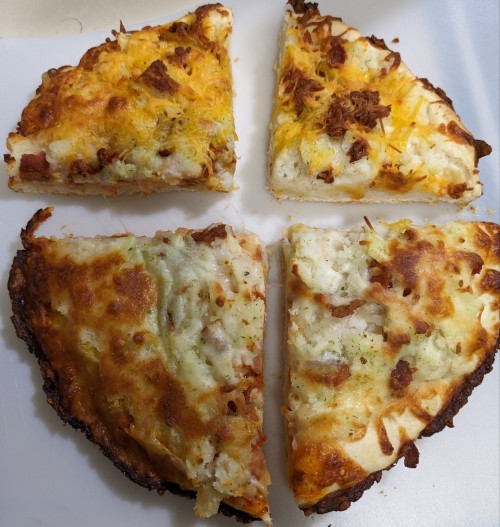

[ID: Two images of the same experimental pizza; it is sliced in four quarters. In the second image, each slice has one giant bite taken out of it, right at the point, so that it looks like the pizza has a hole in the middle of it.]
I live alone, if I want to take a bite out of every slice of pizza, it's fine.
Anyway, my tasting notes are thus:
-- I still prefer mozzarella to cheddar. Cheddar gets kind of nasty when it melts open like this. Crunchy and oily, not a fan.
-- The bacon bits were either too large or shouldn't be there at all. I'm not a fan of bacon on pizza for texture reasons; the bacon should be a flavoring, I think.
-- It needs sauce. It just does. Mashed potatoes straight onto pizza crust is too much dry stuff at once. The mozzarella helps, but only so much. The pizza sauce, while it did add a nice texture, was not the right flavor for the potato. I think instead of pizza sauce, a bacon-ranch sauce would be ideal, incorporating the bacon flavor without adding too much crunch.
-- A perfectly nice pizza, but like, there's no reason to do this other than novelty. Arguably just making 'tato skins would be easier. Still, it's a fun thing to serve at a party or something.
I did have some leftover bacon so I made a bacon-onion sauce out of sour cream, a tiny bit of milk, the remaining bacon, and a generous spoonful of dried onions.

[ID: A sour cream cup with a fork in it; the cup is about half-full of a sour cream sauce with red and green flecks of bacon and onion.]
I'll try dunking the reheated pizza in it and see how that goes. But I'm willing to call this a qualified success. Eminently edible, and it was fun to do!
130 notes
·
View notes
Text
I think, as a Vetinari/Drumknott shipper, The Last Hero has the potential to be the most beautifully heartbreaking book for them in the whole Discworld, despite the fact that Drumknott is never even named in it.
Some spoilers under the cut, though the biggest spoiler is probably that the Discworld series continues afterwards...
The Last Hero follows not long after the Truth (my best guess at the timeline puts it somewhat arbitrarily in the late summer of the same year, not long after Night Watch/ Thief of Time), where Rufus demonstrates the extent of his faith in Vetinari. By the end of the book, their trust in each other is apparent- Drumknott has protected Vetinari's reputation, and Vetinari brings Drumknott with him to The Times' offices, arguably simply as a companion. We see the beginnings of the two of them working together as a unit, in the way which is so much fun to read in Going Postal.
And then The Last Hero arrives, and Vetinari finds himself having to organise an effort to save the world, because essentially no one else can be trusted to get all of the different parties to work together well enough to get things done. And, because the planning and preparation will have to carry on during the sea journey to get there, he has to leave the city. It's a simple choice- if he doesn't go, and it doesn't work, there won't be a city. But if he does go, he's leaving the city at a time of crisis under a temporary governance. And even if the mission succeeds, there's no guarantee that Vetinari will make it back to Ankh Morpork. Worse things, as they say, happen at sea.
Drumknott isn't mentioned in TLH, so it's a fair assumption that he stays in the city. Which brings us to my personal headcanon: Vimes and the guild council are nominally in charge, but essentially Vetinari has left his beloved city in Drumknott's care. Which is a frankly remarkable show of trust, and is one of the reasons I like to envision them established in whatever type of relationship (platonic or not) you prefer to see them in by this point.
And then, think of it from Rufus's perspective. This is not the first time he has had to stay at home while Vetinari sets out on an uncertain mission. In Jingo, Rufus seemed to simply keep his head down- Lord Rust had taken over, after all. But now, he has to wait, and try to stop the city falling into chaos as word spreads of the potential end of the world, and hope against hope that Vetinari will come back to him. He has to stay, and do what he can, and Vetinari has to go. They have to face the end of the world apart, knowing that there is no other choice, because their loyalty is to each other but their duty is to the city. Sometimes I think of Rufus, alone at night, exhausted after a day of fighting fires but unable to sleep with worry for Vetinari, and with no news of if the mission is going to plan, or if it has proved hopeless and the world will end, and they'll never see each other again. And for a man who lives at the centre of Vetinari's web of information to suddenly have no news and no ability to change the outcome, it must have been so hard.
#I’m Fine I’m not crying why do you think I’m crying#just giving myself feelings that’s all#discworld#havelock vetinari#rufus drumknott#Vetiknott#h/r#havelock vetinari/rufus drumknott#the last hero
80 notes
·
View notes
Note
You're writing for the new TD? That's fun! I cannot wait to see more of it 🫶 Would it be possible for if you wrote about contestants that have no dating experience and ask their fellow contestants for flirting advice and strategy? I think this would be especially fun with contestants like Zee, Priya and so on! Thank you if you're writing this! 👐
I already like you anon, that’s a good req. I’ll do a part two if u want, with all contestants even. But for now I have only a few cause some just fit the prompt more/I have an idea for them. So those will b: priya, zee, axel, scary girl, ripper, chase. If you think I have a fav team - you’re totally right haha
Also I hope I understood correctly. If not I can redo it. Like, the character is into sbd (reader) and they ask their friend for advice, yeah?
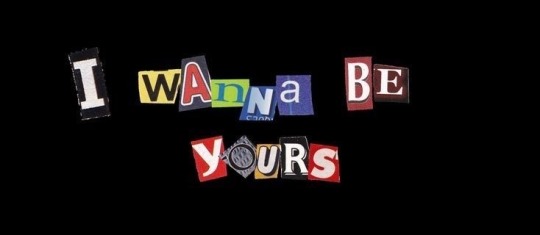
-> Priya
We all know that her whole thing is being prepared, setting goals and reaching them. Whether it’s Total Drama or med school, she has it all figured out. But there was never any camp or class on having a crush. That’s why, when she realises that she has one, she goes to Millie for help. She has a way of looking at having one as if it’s a task she needs to accomplish, a challenge to win. Needless to say - it didn’t do much. Her crush might not even know she likes them at that point. So to stop herself from making things worse, she confided in her best friend. Millie, as a fan of traditional values above all, thinks that being kind and honest about her feelings is the way. To help Priya overcome her nerves, she proposes that she should get used to her crush by being around them in a group setting. Also, as she states, chivalry can do wonders. After a few days Priya did get more comfortable around her crush, even if only a little. Any time they need help - she’s there! Even if it’s just opening doors. As they get more comfortable with each other, she’ll even propose training them. After all, Millie said that the power of true classical romance can conquer all
-> Zee
As much of an easy going guy as Zee is, he does get a tiny bit worked up about his crush. There never was much of a desire to get into a relationship. Although he is a private person, he does mention some of his feelings to Chase and Ripper. Ah, my sweet summer child. That poor guy had no idea. As soon as they hear him mention having a crush, their eyes light up and they have him sit down, so that they can tell him EXACTLY what to do. They swarm him with incoherent advice, talking one over the other. They see this as their way to show off their incredible game. Of which they have arguably none. They make a ‘game plan’ for Zee, but half of it goes over his head. The other half of information still deals massive damage though. So every time he talks with his crush he pulls those weird moves that do nothing but confuse both parties. He mixes up the pick-up lines, makes multiple failed attempts at the yawn-thing and doesn’t even really get how those things are supposed to improve anything. Imo he’s too chill to really go all out and try to win sbd over in any dramatic way. And acting like somebody different is against his own beliefs. So he only ever listens to their advice if he thinks that it will make his crush happy. That’s for the best to be honest because Chase would be projecting his feelings for Emma and living through Zee’s situation. And I can see Ripper totally quoting some date coach he watches, like, build your crush up and then destroy them to show them who’s boss, don’t smile at women to make them think they have to work for it, compare them to other people. Thankfully it doesn’t work bc it’s Zee we’re talking abt, he wouldn’t. So, good on him. And his crush.
-> Axel
My girl definitely takes her time to realise she might need help. At first she would be trying to impress her crush with her survival skills. But showing up with wild animals half cooked on a stick or leaving trinkets at their shoes might not be the best idea to get her point across. This girl’s like a cat fr! I feel like she would maybe ask Nichelle since she always seems so confident and Axel is one of the only contestants that isn’t intimidated by her fame. Asking her might sound like a good idea, but uhm,, it’s very hit or miss. She doesn’t actually have much dating experience and just like with being athletic - she’s better at talking than at doing. But if anyone can advise Axel how to approach people- it’s her. The key to get to know her crush. She advises Axel to approach it like a task, like learning a new role. Observe, maybe ask their friends or them is she’s not sure about something. Ask them questions about themselves too. It’s not too romantic but it works.
-> Lauren
I’m not sure how badly the things would have to get for her to ask anybody for help. Her methods are… uncanny to say the least. She’s not above tormenting her crush for the hell of it. Actually, it might be her favourite thing to do. But it doesn’t get her far. That’s where Priya comes in. Since they became friends she would feel a bit more comfortable asking Lauren about the whole… situation. She’d be glad to help (despite having very little experience herself) but I can’t imagine Scary girl jumping on the chance. After some time she would give in though, if her crush gets too scared of her. Priya would try to get Lauren to open up more and it’s probably terrifying for all parties involved. But in the end she does convince her eerie friend to at least try to hint to the person that she’s interested in them romantically and will NOT hunt them down for sport (most likely). It’s Scary Girl we’re talking about so it’s about as romantic as it gets
-> Ripper
Just like he said, he has tons of experience and kissed a lot of girls. He’s just… unused to caring about one person. Yeah! Bc, yk, usually he keeps a rotation of hot chicks. No need to get all worked up over one girl that he could very easily have. Still, he does ask Chase for advice. Because he’s a bro and because he’s more so the type to get with someone long term. So, perhaps if his crush proves to be worth it, he might need help with starting his first serious relationship. Ripper’s idea of getting his crush to like him back is to get rich and/or famous. Then they will find him hot. If he’ll have money then he’ll be attractive and cool. Right? Well, Chase does entertain the idea but also tries to get his bro to rizz his crush a little earlier than after they all leave the show. It’s not like he has to ask him long, Ripper has a collection of lines straight from his favourite alphalpha pick up artist podcast and is ready to use them. Chase mostly just hypes him up. But also advises him against things like, yk, farting or talking about human waste (which should be a given but isn’t). Though Ripper is on the fence about it I can see him listening to the advice depending on how his crush reacts to those things. Also Chase tries to be his wingman. Which completely blows his cover, if his crush didn’t know Ripper liked them before - they sure will after Chase gets involved
-> Chase
Now, Chase has definitely been in a relationship. But realistically speaking it could have been his first and only one. And though he’s great, objectively his crush might not jump on the chance to be with him. Like, he’s not rly, yk, emotionally mature. Also, like, he did pee himself/right on the sidewalk on a date bc he couldn’t hold it and that seemed like the best option. Would sell his crush for pizza too. But! He is persistent. And strangely charming in his own failboy way. Still, if puppy dog eyes and following his crush around doesn’t work then he will ask his bros. It will either go great or very very badly. Because Zee could genuinely have some decent advice. And it’s not that Ripper can’t get good ideas. But I feel like he would get really focused on proving his experience with girls and not on actually helping. All in all at least Chase isn’t shy about his feelings, because the flirting advice he is given varies in quality. But at least his crush will know how he feels ig
#listen I’m not even clowning on the podcasts#I listen to some on yt myself even if I can’t really say I need all advice#like yk for dating bc it’s rly gendered#I’m more so expanding on the satire that is his character like ik he’s a parody of the type of guys that often even the hosts of these shows#disagree with#x reader#fanfic#imagine#x y/n#total drama x reader#tdi x reader#td x reader#Priya x reader#axel x reader#zee x reader#scary girl x reader#chase x reader#ripper x reader
98 notes
·
View notes
Note
Hey there. Saw a response you gave to a fae who was exiled from Hy Brasil. You recommended they ask to speak to someone from a "higher court" because it's important to get Paradise involved as a higher party. So, I'm kind of curious about the implications of fae-angelic relations. Not only that, does everyone have a right to invoke speaking to a "higher court" in this fashion? is the Choir the *only* higher court? Are demons considered part of a "lower court"? Just curious, thank you. :-)
What a great (and quite complicated) question! The whole situation is very complex, a lot of moving parts, but it boils down to a few things.
The first thing is the relationship between Paradise and the Court.
The first angel-fae contact was several hundred years ago, near as we can tell, since before Paradise and Pandemonium's ceasefire. Over time, many of the old Court structures had varying stances on the war, with some siding with Heaven and some with Hell - but one of the peculiar features of the Old Court is their respect for Paradise's (arguably similar) hierarchy, along with an appreciation for their likelihood to side with the fae in matters of contract disputes.
See, even while the War was ongoing, demonic contract law was respected by Paradise's courts, even if they didn't like it. Demonic contractual magic is considered nigh unbreakable to Angelic structures, which is why Paradise has courts in the first place. Earth isn't the first world they've battled over, and humans aren't the first mortals both Paradise and Pandemonium have exploited - along with the conventional arms race, they've engaged in a legal magic arms race for millennia. Upon meeting the Fae and establishing diplomatic relationships, both parties (but particularly angels) developed a begrudging respect for the literal-agreement magic the Fae employ as well as their complex system of bindings and geas. Some demonic attorneys are actually trained in lower, mortal, higher, and fae Court law. It's a fascinating topic, if you like contract disputes. I...guess that's why I don't get invited to parties much.
Anyway, this resulted in an ancient agreement called the Empyrean Accords. By an incredibly complex system of syncretistic legal agreements, most living Fae and all Angels still in favor with Paradise are bound by a non-intervention pact coupled with a promise to advise each other in legal matters. Angels are simply not allowed to interfere in fae business, and vice versa, and must take any issues to the aforementioned Higher Court, which can take decades.
If you're ever in hot water with fae you suspect to be of the Old Court, you can ask for your case to be heard by a Higher Court - in most cases they will oblige, and even though Paradise archlegals will often side with the Court, you can buy time that way.
Demons are colloquially called the "lower court," but for a mortal to invoke that right, they'd have to be very, very careful about their next steps.
I stayed late to answer this question because it's a topic I'm interested in! Hope you found it as interesting as I did!
32 notes
·
View notes
Text
for fun, thoughts on each of the original gotei 13's captains and lieutenants in relation to the soul society arc
yamamoto: for the kind of character he is, i've always rather liked him. he hits the kubo sweet spot of a sympathetic monster, and overall he serves as an effective symbol of the calcification thats gripped soul society for thousands of years but without being completely unreasonable in the process. ontop of that i do appreciate the suprise of the tybw noting how the original gotei 13 were far stronger then the modern gotei, but because of the intervening centuries they lost the blood thirsty edge of warlords that made them so terrifying, because it adds an interesting dimensionality to the sentimentality yamamoto often displays to that modern gotei 13 and what distinguishes him from ywach despite being similarly brutal, overpowering authoritarian figures. which can be further complicated by reading into yamamoto and his history as a stand in figure for japan and its history as a whole, though obviously thats just reading into things.
sasakibe: like so many figures in bleach, more a plot device then a man. i like his design, i like his power, i like his relation to yamamoto and the grief that his death inspires in the resolute head captain. but hes otherwise such a non entity that theres not much else to say.
soifon: shes cute and i find it absolutely adorable how shes a murder simp for yoroichi. aside from that serves as a pretty fun minor antagonist in the soul society arc, and i enjoy how shes very a 'do as i say not as i do' kinda person who cares waaaay to much for her subordinates despite being the head of the gotei black ops murder squad. which arguably ties into her complicated feelings regarding yoroichi and the feeling of being abandoned when yoroichi had to go into exile [which makes it all the cuter that they patch things up, albeit off screen].
omaeda: not a fan as i think he can be a bit too annoying compared to his moments of competence, and the joke of 'big goofball is actually an elite assassin' does wear thin for me. i do appreciate how hes genuinely devoted to his captain and how that feeds back into soifon being more willing to do stupid things to keep his ass alive due to her own history.
gin: gin saaaaaan! always been a fan of the shit stirrer and his grins and constantly closed eyes. gin is one of the characters kubo used to best effect in all of bleach i'll go out and say, serving as an excellent red herring in the soul society arc, and a strong third party looking for the right opportunity in the winter war ontop of his tragic and well presented death. plus hes just a fun unnerving dude who can easily go from goofy to terrifying looking at the drop of a hat and for whatever kubo needed him to do.
kira: hes okay, helping to make the soul society arc and its mysteries all the more intriguing, and his power is neat. plus his gloomy demeanour does well at hiding how intelligent and decisive he is in a fight which is nice. as it stands however hes one of many characters that feels unfulfilled in terms of potential, not helped by whatever the fuck was going on with him in the tybw.
unohana: theres a reason everyone liked her even before the tybw and kenpachi 'mc fucking losing it' unohana became realized. kubo just did a really good job at giving a character with such a non threatening design overall the atmosphere of such a potential dangerous person well still overall acting in a kind and mothering way in most of her interactions. i still find her shikai kinda confusing in relation to her bankai though, but thats retroactive writing for ya.
isane: i get why she ended up being pushed into the role of fourth division captain at the end of the series as there really wasn't any other option for it that would make sense. but at the same time it does frustrate me because i feel like with that end in mind it would have been amazing to see kotetsu develop the confidence or display the combat skills that speak of potential captaincy over the course of the series, but she ultimately just kinda white mages it up well deferring to her captain. which is even more of a shame because i love her personality and her design.
aizen: aizen is amazing in the soul society arc, because hes an incredibly successful twist villain whos plan makes sense and is intimidating not because of its complexity but because of its simplicity. hes unnerving because of how he combines the captain aizen qualities we briefly glimpse of affability and politeness, even kindness, with casual and monstrous cruelty and overwhelming power once the mask comes off. aizen is fantastic in the soul society arc. that all goes out the window following the soul society arc, where after he just walks around preening like any other peacock chess master villainous overlord about how everything is going according to keikaku, not helped by his plans and what influence hes had on things becoming progressively more complex, far reaching, and stupid as the series progresses. its really not surprising why hes such a contentious villain for so many people.
hinamori: man she gets the shit kicked out of her, to the point that it gets really cruel and sad. and the worst part is that theres never really a sense of pay off for all that suffering either, she gets the shit kicked out of her and then fades into the background of relevancy. i feel it woulda been cool if instead she got to be a captain following the timeskip into the fullbringer arc, get some satisfying sense of karmic self actualization following all the shit she gets pushed through. woulda been more interesting then just dumping the visored into the empty spots anyways.
byakuya: pretty boy pretty man. an effective rival antagonist for ichigo to match up against in the soul society arc, and i find his development from cold and ruthless to finally displaying the buried emotions and affections he has for others in his life to be some strongly compelling stuff given the heartbreak and tragedy in his life, as well as an effective commentary on class, position and the stifling effect that rules and the expectations of conformity and propriety can have on individuals.
renji: he deserves to be one of the main characters i'd say. overall solid stuff.
komamura: big fluffy dog man ruff ruff. theres a lot to unpack with komamura that i feel bleach never really did, but what was done with him was at least compelling and interesting to see. plus he fights far more intelligently then his broiling blood and brute force powers might suggest he would which is fun to watch. plus hes a big dog man! whos a good boy? he is!
iba: well an easily likeable character, being a gruff exterior dude with a surprisingly insightful mind on people and their character, like isane he doesn't really... do much outside of accompanying his captain. and well hes a total devoted bro, it is frustrating the he ends the series in a captains seat without being allowed to showcase the kind of potential that would inspire that positioning.
kyoraku: an effective captain jack sparrow type, who gets more compelling but also scarier the more insight we get into the tragedies that have befallen his own life which tend to scale with how viscous he can be in proportion during combat.
nanao: i feel like her fight in the tybw really helped salvage her as a character, because well she was perfectly acceptable until then she was also kinda just background noise as kyorakus secretary like lieutenant who freaked out hard to show off how powerful yamamoto is. her fight with the chicken god angel however opened a lot more compelling aspects of her character and the ending involving gaining courage from kyoraku assuring her he'll always support her is sweet in relation to how their character dynamic is a lot more give and take equally between the two.
tosen: i feel like kubo ran into the problem of what to do with tosen when it came to how aizens power works, and so he just kinda gave up and made tosen a surprise third bad guy as a character. i say this because he gets his ass handed to him quite brutally by zaraki and has a whole little character thing during that fight, and then the betrayal happens and he suddenly feels like a completly different character acting like he shouldn't be keeled over/nearly dead from being almost killed by kenpachi like ten minutes ago. doesnt help that his contributions during the winter war are mostly just to fuel komamura and hisagis own angst by being as villainously despicable as possible in the brief ten minutes he has showing off weird new powers that never really get expanded on again and then unceremoniously killed off in an abrupt and cruel fashion to have aizen be a cheeky bastard.
hisagi: i feel like kubo wanted hisagi to be more of a thing then he ended up being, but what is there is a solid character nonetheless who ends the series getting a bit of a yamcha treatment unfortunately. which is rather frustrating.
hitsuyaga: theres a lot more anger and impatience in him when we first meet him compared to later, which could arguably be said as character development or could be called out as inconsistent but im not gonna split hairs. hes the kind of character the inevitably gets popular and in his particular case i do rather like him so thats a plus.
rangiku: like gin shes great though for different reasons, and like a lot of characters like her i feel her more interesting qualities, the ruthlessness she often displays in combat, her intelligence and master of social situations, often get lost in favour of people slobbering over her sex appeal. shes a real fun character overall though.
zaraki: a bit overhyped if im being honest, but as far as battle maniac intense bloodlust dudes go hes a solid 8/10. it helps that hes a lot more emotionally vulnerable and complex in that regard then shonen battle maniac bloodlust dudes can often be.
yachiru: adorable murder girl is an adorable murder girl mascot. the stuff in regards to her relation to kenpachi not just as a girl he takes care off but a manifestation of his inner desire for companionship and the sword spirit stuff are i feel more interesting then she herself is.
mayuri: if his first appearance hadn't been so harrowing i feel he would have ended up being more popular then he is. he serves as a personal demon for uryu to fight very effectively, but as others have pointed out he quite obviously gets reconnected to be more charming and goofy then he originally was in later appearances. i actually find his tybw role to be the most interesting however, as it often feels hes at something of a crossroads there still embodying the older gotei mindset of peace at any cost, that older darkness, thats coming into conflict with the newer ideals and gentleness the gotei is starting to move towards thanks to figures like ichigo, a conflict he only resolves on a personal level upon nemu's death by not so much repenting as resolving that hes not gonna wallow in the old darkness and change with the times instead. that's the way i interpretted it anyways, which i feel gels with how he seems far more gentle with hachigo nemuri then he was with nemu from what little of them we see. also, i do find it interesting how he seems genuinely taken aback to some extent by ikkaku genuinely thanking him for saving zaraki, which when combing through what details we have of his past suggests some desire to actually connect with the people around him that he tends to bury due to his research and troubles with interpersonal relations in the past. which is all fascinating in its own way, but also as noted before, all comes from his post uryu fight soft character retcon where he becomes goofy murder scientist as opposed to horrific murder scientist.
nemu: eh. in her first appearence shes more so there to remind us that mayuris a monster. and in later appearances shes just kinda there to be weird fetish bait for villain powers, and unnaturally strong. and then she blows up. point being i feel like she never really finds solid footing as a character, which makes it difficult for me to really care all that much. it kinda happens at the very end, but again... she blows up pretty quickly after. essentially needed more time to cook as it were.
ukitake: less developed kyoraku but instead of being a jack sparrow type hes a sickly man whos secretly a bad ass. i dont dislike him, i just kinda wish we got to see more of him before he croaked.
kaien: is black haired ichigo. effective in relation to rukia and her character journey and story, but i dont personally have much interest in him.
7 notes
·
View notes
Text
Today I was reminded of a work incident from a few years ago, so let me tell you about the Infamous Shit Circle.
It's 2020. I've recently returned home from college after the dorms were shut down due to pandemic reasons and needed a job to financially and emotionally sustain myself. I ended up working at a provincial park campground (while this was arguably the worst job I've worked, it was also the most beautiful place I've worked at. We take our wins where we get them).
The world is pretty insane and where does everyone escape to when they want to pretend everything is fine? They get lost in the woods for an undetermined amount of time.
Aka they go camping.
When I say everyone was looking for an escape, I mean *everyone.* Anyone with a tent and a dream was out there, especially the highschoolers. Specifically, the highschoolers who weren't allowed to party like usual (again, pandemic restrictions) but needed some sort of outlet. Partying in the woods was that outlet. Technically the campground shouldn't have allowed this but frankly, my bosses didn't care and I wasn't paid enough to rock that particular boat. Nor was I paid enough to deal with the outcome of their parties.
Picture this. You're driving the little gator loaded with cleaning supplies up to campground loop C. It's the most "in the woods" area you can get, furthest away from the lodge and campground spots are far enough away from each other you could reasonably not see or talk to anyone else for your whole stay and that'd be normal.
The first thing that hits you is the smell.
It's the woods, campground outhouses are nearby, sometimes you'll just catch a wiff of feces but this? This is bad. This is worse than bad. This is offensive. This is a violation of the Genova Convention.
(Fun fact! When you smell something, it's because you're smelling the particles of that something in the air, which is now in your nose, triggering all those lovely olfactory senses.)
You hope to god that this stench is just the result of an animal's stomach ache, a freshly emptied RV waste tank, but you know it isn't.
Then you see the toilet paper.
Streams of toilet paper trail up the road, dangling from trees like poorly hung streamers at a 5 year old's birthday party.
All leading up to one campground you'd already heard about this morning. The campground that'd been cause of multiple complaints throughout the night. A group of 18 to 20 somethings, responsible for excessive noise, disrupting campground neighbors, making a mess of the place, all things that you'd come to expect from party hard campers. You wonder what those noise complaints specified, but now you don't really want to know.
You pull into the campsite and for the first time all summer, you geniunely consider quitting on the spot.
In the middle of the campsite is an almost perfect circle of Human Feces. It's like a group of people got into a circle, popped a squat, and collectively experienced the Sugar Free Haribo Gummy Bears Colon Cleanse.
It got worse. There was more shit outside the campsite, creating a nice little border. More toilet paper hung from the trees, some of it clearly used. Empty beer cans, food wrappers, and other garbage was strewn through the trees.
So what do you do? What do you do after witnessing the aftermath of a remarkably shitty party?
You drive back to the shop and get the big shovel.
#work story#human feces mention#“there's no way this was legal for you to clean up” probably not! unfortunately I still did it and it was horrible.#The worst part?#This was the second human shit related incident that summer#The first one involved an outhouse#vacuum#and poorly placed beach towel#the toads want your bones#the toads don't want your shit#literal shitpost
2 notes
·
View notes